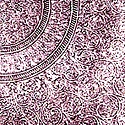Mural paintings on the rock cut cave monasteries at Ajanta (2nd – 5th CE) depicting figures clothed in speckled textiles provide evidence of a long tradition of patterning through tying and dyeing . Variously called bandhej in Gujarat, bandhini in Rajasthan and Madhya Pradesh and sungadi in Tamil Nadu, the terms are derived from the Sanskrit word for ‘tying up.’ While the techniques used are relatively similar each center is differentiated by its own practices of patterning and color usage that have been customized for their traditional clientele.
The Bandhani found here is unusual and very attractive. The main centres are Tarapur and Umedpura; Bhairongarh is a smaller centre. The Gambhiri river which flows in this region has its banks full of drying bandhani fabrics. The popular motifs include the dana pattern that is formed by chains of grain on the body of the fabric with elaborate designs on the borders and pallu. The gaps between the bands of dotted lines are filled with motifs and the borders have zig-zagging lines on them. The designs on the body of the chunris can be squares dots, clusters of dots, flowers, and birds. The colour combinations of the saris or chunris are mainly indigo-blue and red. In Indore, bandhani is less widespread being confined to head-mantles and lugdas – the sari-like dress of the Jat, Chamar and Banjara tribal community.
The bandhani owes its attractive appearance to contrasting bright colours, lines, and trace-figures.
A woman’s upper garment made in the bandani style called pillya. This is a speciality of Jawad. The background colours are mainly red and the motifs are leaves, flowers, dolls, and elephants. In Jawad, hair strings or parandas in the bandhani style are also crafted from cotton yarn in several colours.
Gallery
YOUR VIEWS
PRACTITIONERS: INDIA
Access 70,000+ practitioners in 2500+ crafts across India.
BIBLIOGRAPHY
10,000+ listings on arts, crafts, design, heritage, culture etc.
GLOSSARY
Rich and often unfamiliar vocabulary of crafts and textiles.
SHOP at India InCH
Needs to be written.






